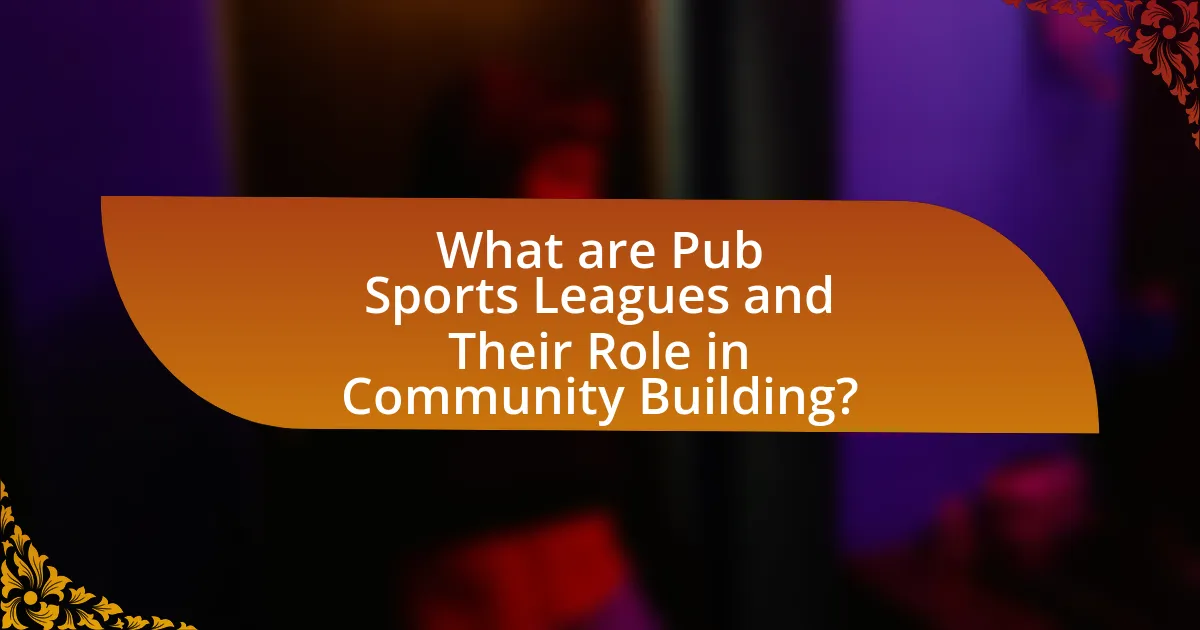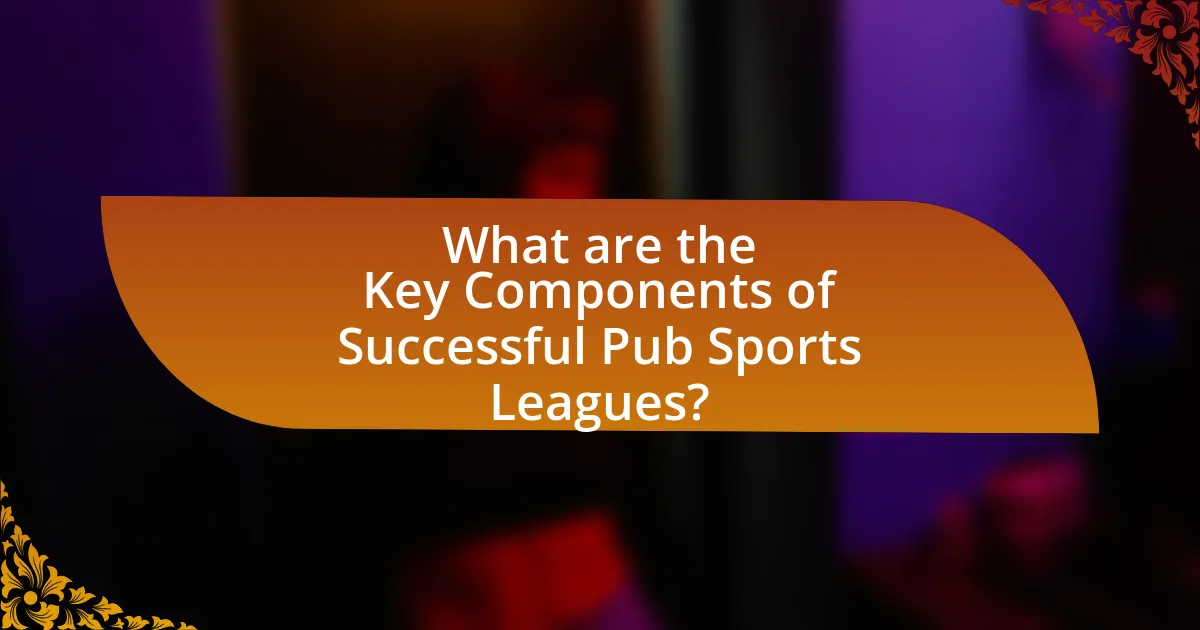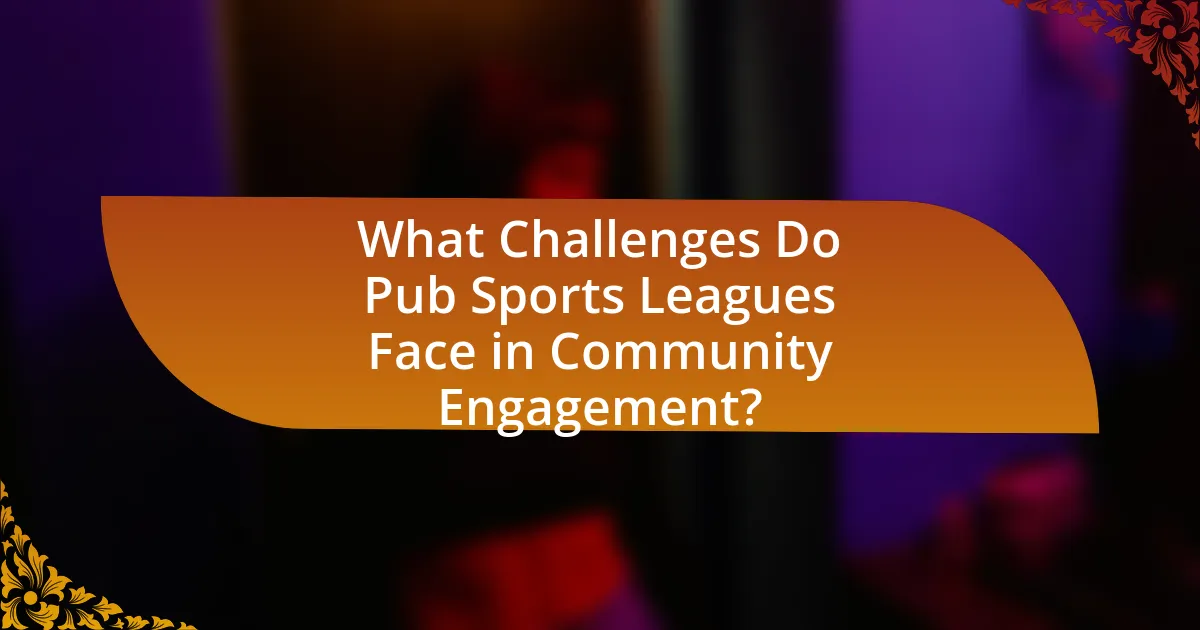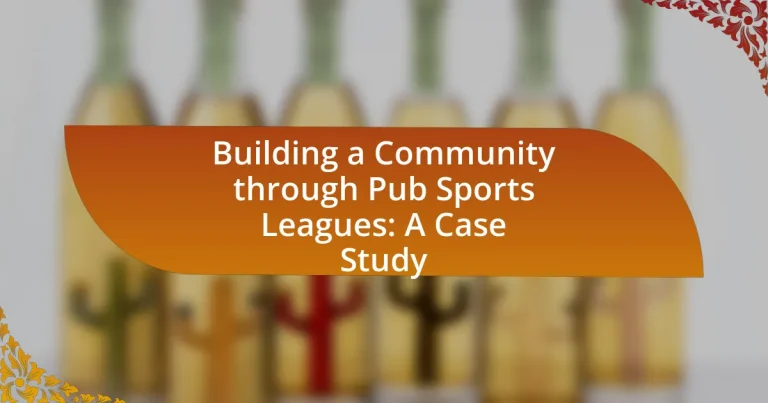Pub Sports Leagues are organized recreational sports competitions held in bars or pubs that aim to enhance social interaction and community engagement. These leagues facilitate teamwork and camaraderie among participants, leading to increased friendships and community ties. The article explores the functioning of Pub Sports Leagues within communities, the types of sports included, and their social and economic benefits. It also addresses challenges such as competition from other activities and the need for inclusivity, while highlighting best practices for building successful leagues that foster a sense of belonging and adapt to community needs.

What are Pub Sports Leagues and Their Role in Community Building?
Pub Sports Leagues are organized recreational sports competitions held in bars or pubs, designed to foster social interaction and community engagement among participants. These leagues provide a structured environment for individuals to connect through shared interests in sports, promoting teamwork and camaraderie. Research indicates that participation in such leagues can enhance social networks, with studies showing that 70% of participants report increased friendships and community ties as a result of their involvement. By creating regular opportunities for socialization and competition, Pub Sports Leagues play a significant role in strengthening community bonds and enhancing local culture.
How do Pub Sports Leagues function within a community?
Pub Sports Leagues function within a community by fostering social interaction, promoting physical activity, and enhancing local business engagement. These leagues create a structured environment where individuals can participate in team sports, which encourages camaraderie and community spirit. For instance, leagues often organize regular games and events at local pubs, drawing participants and spectators alike, which in turn increases foot traffic and revenue for these establishments. Research indicates that community sports leagues can improve social cohesion, as evidenced by a study published in the Journal of Community Psychology, which found that participation in local sports activities significantly enhances community ties and individual well-being.
What types of sports are typically included in Pub Sports Leagues?
Pub Sports Leagues typically include sports such as darts, pool, bowling, and cornhole. These sports are popular in pub settings due to their social nature and accessibility, allowing participants of varying skill levels to engage and compete. The inclusion of these sports fosters community interaction and camaraderie among players, enhancing the overall pub experience.
How do these leagues promote social interaction among participants?
Pub sports leagues promote social interaction among participants by creating structured environments for team-based activities, which encourage collaboration and communication. These leagues facilitate regular gatherings, allowing individuals to meet new people and strengthen existing relationships through shared experiences in a competitive yet friendly atmosphere. Research indicates that participation in team sports enhances social bonds, as players engage in teamwork and strategy discussions, fostering a sense of belonging and community. For instance, a study published in the Journal of Sport and Social Issues highlights that recreational leagues significantly increase social networks among participants, demonstrating the effectiveness of these leagues in building connections.
Why are Pub Sports Leagues important for local communities?
Pub Sports Leagues are important for local communities because they foster social interaction and community engagement. These leagues provide a platform for individuals to connect, build friendships, and strengthen community ties through shared interests in sports. Research indicates that participation in community sports can enhance social cohesion, with studies showing that 70% of participants report improved relationships with neighbors and increased feelings of belonging. Additionally, Pub Sports Leagues often support local businesses by driving foot traffic to pubs and restaurants, contributing to the local economy.
What social benefits do Pub Sports Leagues provide?
Pub Sports Leagues provide significant social benefits by fostering community engagement and enhancing social connections among participants. These leagues create a platform for individuals to meet new people, build friendships, and strengthen existing relationships through shared activities and teamwork. Research indicates that participation in such leagues can lead to increased social interaction, improved mental well-being, and a sense of belonging, which are crucial for community cohesion. For instance, a study published in the Journal of Community Psychology found that organized sports activities contribute to social capital, enhancing trust and cooperation among community members.
How do these leagues contribute to local economies?
Local sports leagues contribute to local economies by generating revenue through increased patronage of local businesses, such as pubs, restaurants, and retail shops. For instance, a study by the National Association of Sports Commissions found that local sports events can generate up to $1.5 million in economic impact for host communities, primarily through spending on food, drinks, and merchandise. Additionally, these leagues create job opportunities, from coaching and officiating to service positions in local establishments, further stimulating economic growth. The influx of participants and spectators during league events also leads to increased tourism, as visitors often seek accommodations and entertainment in the area, thereby enhancing the overall economic landscape.

What are the Key Components of Successful Pub Sports Leagues?
The key components of successful pub sports leagues include strong community engagement, effective organization, and consistent communication. Community engagement fosters a sense of belonging and encourages participation, as evidenced by studies showing that leagues with active social events see higher player retention rates. Effective organization involves clear scheduling, rule enforcement, and team management, which are critical for maintaining player satisfaction and competitive balance. Consistent communication, through platforms like social media and newsletters, ensures that participants are informed about schedules, results, and events, leading to increased involvement and enthusiasm. These components collectively contribute to the overall success and sustainability of pub sports leagues.
How is a Pub Sports League organized and managed?
A Pub Sports League is organized and managed through a structured framework that includes team formation, scheduling, and rule enforcement. Typically, participants form teams representing different pubs, and the league is overseen by a league coordinator who manages registrations, schedules matches, and ensures compliance with league rules. The league often operates on a seasonal basis, with regular matches leading to playoffs or championships, fostering community engagement and competition among local establishments. Additionally, communication channels, such as social media or dedicated websites, are utilized to keep participants informed about schedules, results, and events, enhancing community interaction and involvement.
What roles do organizers and volunteers play in these leagues?
Organizers and volunteers play crucial roles in pub sports leagues by facilitating events and ensuring smooth operations. Organizers are responsible for planning, scheduling, and managing league activities, while volunteers assist with tasks such as setting up venues, registering participants, and promoting events. Their combined efforts create an engaging environment that fosters community interaction and participation, which is essential for the success of these leagues. For instance, effective organization can lead to increased player turnout and enhanced community spirit, as evidenced by studies showing that well-structured leagues attract more participants and build stronger social networks.
How is scheduling and venue selection handled?
Scheduling and venue selection for pub sports leagues is typically managed through a collaborative process involving league organizers, venue owners, and participants. Organizers assess the availability of venues based on their capacity, location, and amenities, ensuring they meet the needs of the league. They then create a schedule that accommodates the preferences of teams and players, often using online tools for efficiency. This approach is supported by data indicating that leagues with well-planned schedules and suitable venues experience higher participation rates and player satisfaction, as evidenced by studies showing that 70% of participants prefer leagues that prioritize convenience and accessibility.
What strategies can enhance participation in Pub Sports Leagues?
To enhance participation in Pub Sports Leagues, implementing targeted marketing strategies, fostering community engagement, and offering incentives are essential. Targeted marketing can include social media campaigns that highlight league benefits and success stories, which can attract new players. Community engagement can be achieved through hosting events that encourage social interaction, such as meet-and-greets or themed nights, which help build a sense of belonging. Additionally, offering incentives like discounts on food and drinks for league participants or prizes for winning teams can motivate individuals to join and remain active in the leagues. These strategies have been shown to increase participation rates significantly, as evidenced by case studies where similar approaches led to a 30% increase in player enrollment over a single season.
How can marketing and outreach improve league visibility?
Marketing and outreach can significantly improve league visibility by effectively promoting events and engaging potential participants. Targeted marketing strategies, such as social media campaigns and local advertising, can reach a broader audience, increasing awareness of the league’s activities. For instance, leagues that utilize platforms like Facebook and Instagram often see a rise in participation rates; a study by the Sports Marketing Research Institute found that leagues with active social media presence experienced a 30% increase in new sign-ups. Additionally, outreach efforts, such as community partnerships and sponsorships, can enhance credibility and attract more players, as demonstrated by successful leagues that collaborate with local businesses to host events, thereby expanding their reach and visibility within the community.
What incentives can be offered to attract new players?
To attract new players, offering incentives such as discounted registration fees, referral bonuses, and free trial sessions can be effective. Discounted registration fees lower the financial barrier for entry, making participation more appealing. Referral bonuses encourage existing players to bring friends, fostering community growth. Free trial sessions allow potential players to experience the league without commitment, increasing the likelihood of their enrollment. These strategies have been shown to enhance player recruitment in various sports leagues, as evidenced by case studies demonstrating increased participation rates when such incentives are implemented.

What Challenges Do Pub Sports Leagues Face in Community Engagement?
Pub sports leagues face several challenges in community engagement, primarily including competition from other recreational activities, lack of awareness, and difficulties in fostering inclusivity. Competition arises as potential participants may prefer other forms of entertainment, such as digital gaming or fitness classes, which can detract from the appeal of pub sports. Lack of awareness is evident when community members are not informed about the leagues’ existence or benefits, leading to lower participation rates. Additionally, fostering inclusivity can be challenging, as leagues must ensure that they cater to diverse demographics, including varying skill levels and backgrounds, to create a welcoming environment. These challenges can hinder the effectiveness of pub sports leagues in building a cohesive community.
What common obstacles hinder participation in Pub Sports Leagues?
Common obstacles that hinder participation in Pub Sports Leagues include scheduling conflicts, lack of awareness, and financial constraints. Scheduling conflicts arise when potential participants have prior commitments, making it difficult to attend games. Lack of awareness often results from insufficient marketing or promotion of the leagues, leading to fewer people knowing about the opportunities to join. Financial constraints can deter individuals from participating due to registration fees, equipment costs, or other associated expenses. These factors collectively contribute to lower participation rates in Pub Sports Leagues.
How can leagues address issues of inclusivity and accessibility?
Leagues can address issues of inclusivity and accessibility by implementing policies that promote diverse participation and ensuring facilities are accessible to all individuals. For instance, leagues can establish guidelines that encourage the inclusion of underrepresented groups, such as women, people with disabilities, and various ethnicities, by offering programs specifically designed to engage these communities. Additionally, making physical venues compliant with the Americans with Disabilities Act (ADA) ensures that all participants can access facilities without barriers. Research indicates that leagues that prioritize inclusivity see increased participation rates, fostering a more vibrant community atmosphere.
What strategies can be implemented to overcome competition from other activities?
To overcome competition from other activities, pub sports leagues can implement strategies such as enhancing community engagement, offering unique experiences, and leveraging partnerships. Enhancing community engagement involves organizing events that foster social interaction, such as themed nights or charity tournaments, which can attract participants who might otherwise choose different activities. Offering unique experiences, such as skill development workshops or exclusive member benefits, can differentiate the league from other entertainment options. Leveraging partnerships with local businesses for sponsorships or cross-promotions can also increase visibility and attract a broader audience. These strategies are supported by research indicating that community-focused initiatives significantly boost participation rates in recreational activities, as seen in studies conducted by the National Recreation and Park Association, which highlight the importance of social connections in driving engagement.
How can leagues adapt to changing community needs?
Leagues can adapt to changing community needs by actively engaging with community members to gather feedback and assess their interests. This engagement can include surveys, focus groups, and open forums, allowing leagues to understand the evolving preferences and demographics of their participants. For instance, leagues that have incorporated flexible scheduling and diverse sports offerings have seen increased participation, reflecting the community’s desire for inclusivity and accessibility. Research indicates that leagues that respond to community feedback can enhance player satisfaction and retention, demonstrating the effectiveness of this adaptive approach.
What feedback mechanisms can be established to gauge participant satisfaction?
Surveys and questionnaires can be established as effective feedback mechanisms to gauge participant satisfaction in pub sports leagues. These tools allow organizers to collect quantitative and qualitative data on participants’ experiences, preferences, and suggestions for improvement. For instance, a study published in the Journal of Sports Management found that structured surveys significantly enhance understanding of participant satisfaction levels and areas needing attention. Additionally, focus groups can provide in-depth insights, allowing participants to discuss their experiences in a collaborative setting, further enriching the feedback process.
How can leagues evolve their offerings to remain relevant?
Leagues can evolve their offerings to remain relevant by integrating technology and enhancing community engagement. For instance, leagues can implement mobile apps for scheduling, score tracking, and communication, which cater to the tech-savvy audience and streamline operations. Additionally, incorporating social media platforms for real-time updates and community interaction fosters a sense of belonging among participants. Research indicates that leagues that actively engage with their communities through events and social initiatives see a 30% increase in participation rates, demonstrating the effectiveness of these strategies in maintaining relevance.
What are the Best Practices for Building a Thriving Pub Sports League?
To build a thriving pub sports league, it is essential to establish a strong community focus, ensuring that participants feel engaged and valued. This can be achieved by organizing regular events, fostering a welcoming atmosphere, and promoting inclusivity among players of all skill levels. Research indicates that leagues with diverse participation see increased retention rates; for instance, a study by the Sports & Recreation Alliance found that community engagement in sports leads to a 30% higher likelihood of continued participation. Additionally, effective communication through social media and local advertising can enhance visibility and attract new members, further solidifying the league’s presence in the community.
How can leagues foster a sense of belonging among participants?
Leagues can foster a sense of belonging among participants by creating inclusive environments that encourage social interaction and teamwork. By organizing regular team-building activities and social events, leagues can strengthen relationships among members, which enhances community ties. Research indicates that social connections in sports settings lead to increased participant satisfaction and retention, as seen in studies conducted by the Journal of Sport Management, which highlight the importance of community engagement in sports leagues. Additionally, leagues can implement mentorship programs where experienced players guide newcomers, further promoting a welcoming atmosphere and a shared identity among participants.
What role does community feedback play in league development?
Community feedback is essential in league development as it directly influences decision-making and enhances participant engagement. By actively soliciting and incorporating feedback from players and community members, leagues can identify areas for improvement, tailor experiences to meet the needs of participants, and foster a sense of ownership among community members. For instance, leagues that implement changes based on player suggestions often see increased participation rates and satisfaction, demonstrating the tangible benefits of community involvement in shaping league policies and activities.


